Augmented Reality for Multicultural Experiences in Australian Tourism
VerifiedAdded on 2023/06/04
|13
|3302
|75
Thesis and Dissertation
AI Summary
This dissertation proposal investigates the integration of augmented reality (AR) into existing marketing strategies to target multicultural experiences within the Australian tourism industry. It aims to explore the meaning and concept of augmented reality, assess its role in tourism marketing, and recommend strategies for improvement. The proposal includes a literature review of previous studies, highlighting AR's potential to enhance brand engagement, provide unique customer experiences, and improve navigation for tourists. It outlines a research plan utilizing interpretivism philosophy, a descriptive research design, and an inductive approach, employing both qualitative and quantitative data collection methods, including surveys and secondary data from academic journals and online sources. The proposal concludes with a timeline for the research, covering issue identification, literature review, data gathering, data analysis, and final report submission.
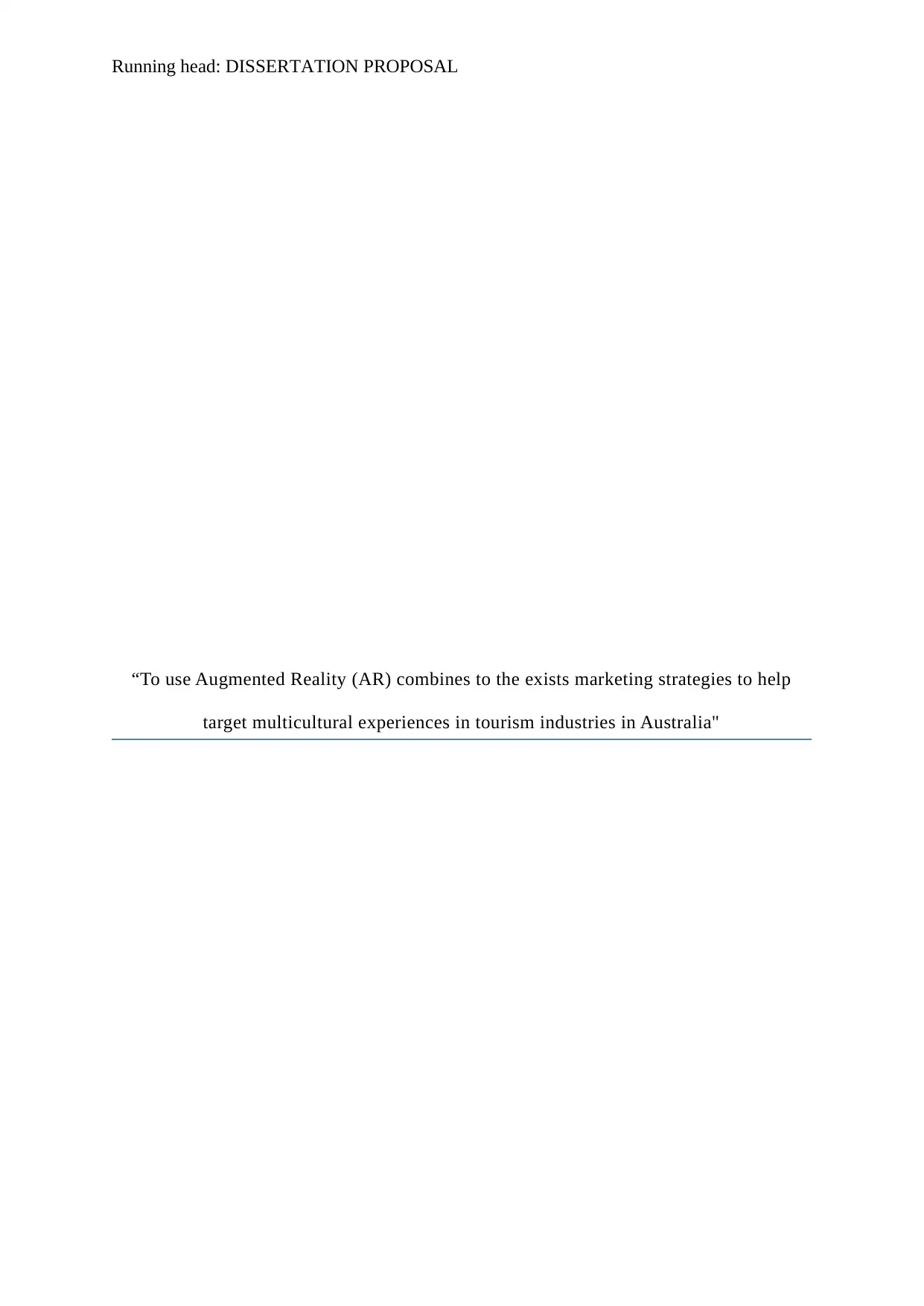
Running head: DISSERTATION PROPOSAL
“To use Augmented Reality (AR) combines to the exists marketing strategies to help
target multicultural experiences in tourism industries in Australia"
“To use Augmented Reality (AR) combines to the exists marketing strategies to help
target multicultural experiences in tourism industries in Australia"
Paraphrase This Document
Need a fresh take? Get an instant paraphrase of this document with our AI Paraphraser
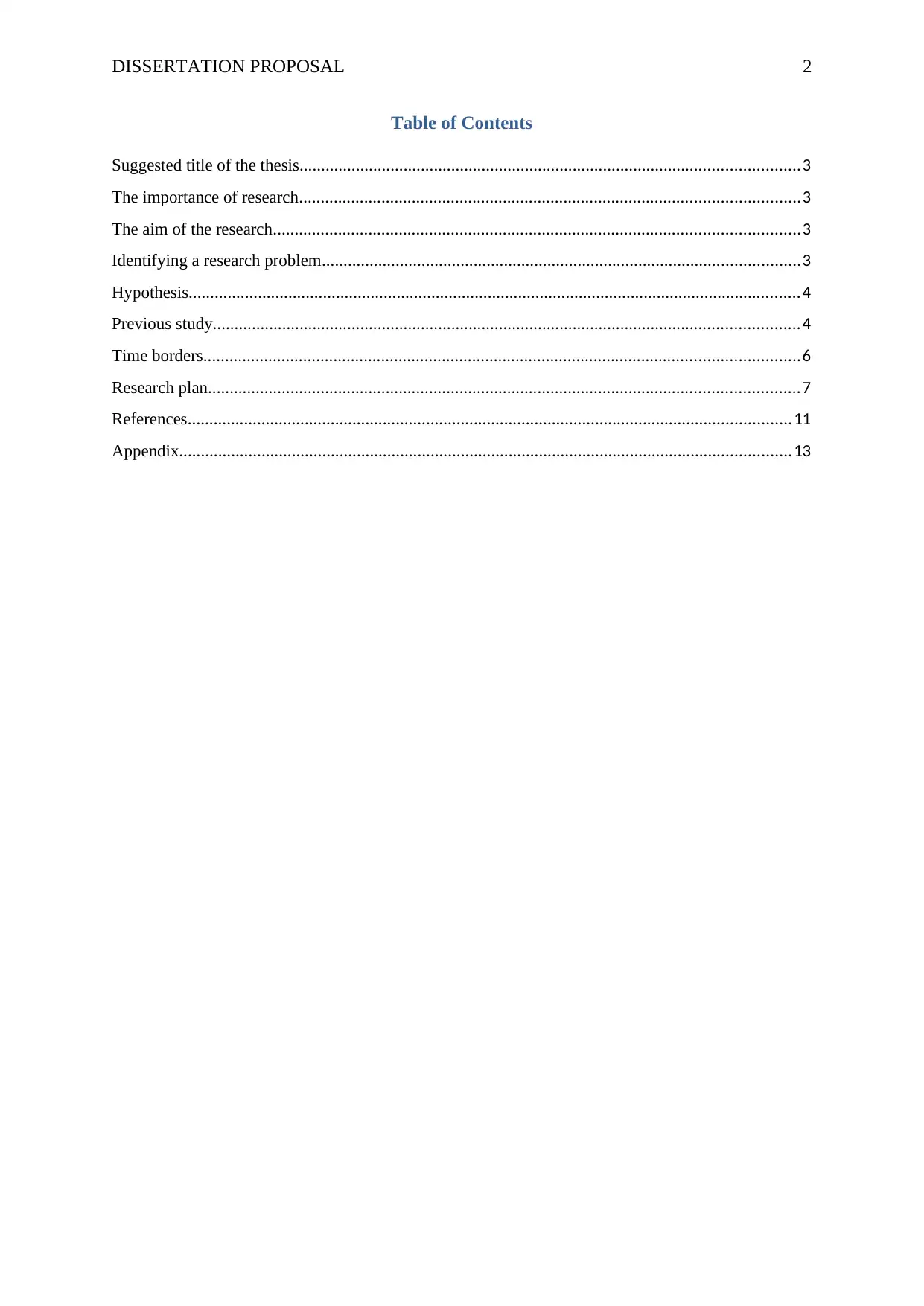
DISSERTATION PROPOSAL 2
Table of Contents
Suggested title of the thesis...................................................................................................................3
The importance of research...................................................................................................................3
The aim of the research.........................................................................................................................3
Identifying a research problem..............................................................................................................3
Hypothesis.............................................................................................................................................4
Previous study.......................................................................................................................................4
Time borders.........................................................................................................................................6
Research plan........................................................................................................................................7
References...........................................................................................................................................11
Appendix.............................................................................................................................................13
Table of Contents
Suggested title of the thesis...................................................................................................................3
The importance of research...................................................................................................................3
The aim of the research.........................................................................................................................3
Identifying a research problem..............................................................................................................3
Hypothesis.............................................................................................................................................4
Previous study.......................................................................................................................................4
Time borders.........................................................................................................................................6
Research plan........................................................................................................................................7
References...........................................................................................................................................11
Appendix.............................................................................................................................................13
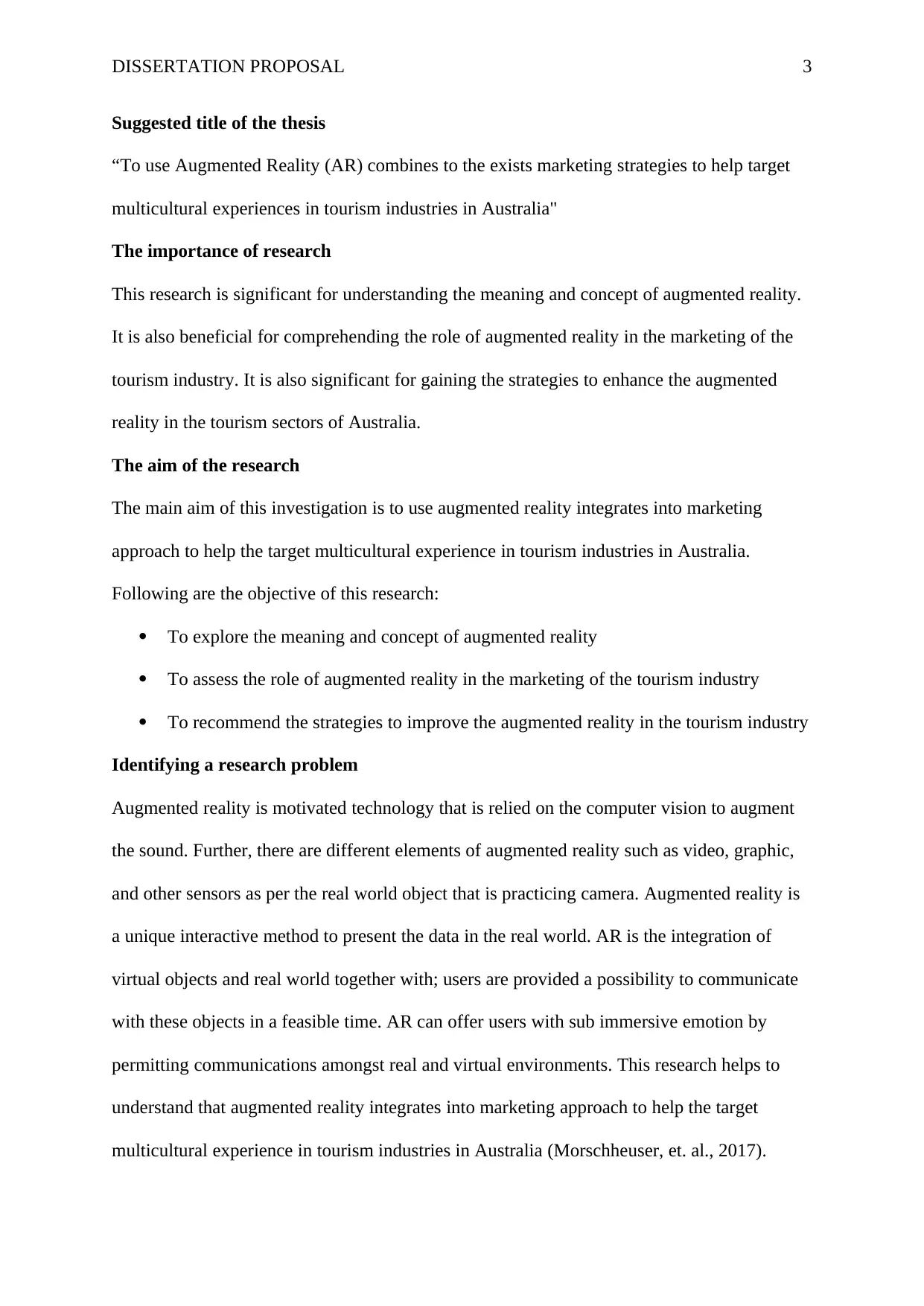
DISSERTATION PROPOSAL 3
Suggested title of the thesis
“To use Augmented Reality (AR) combines to the exists marketing strategies to help target
multicultural experiences in tourism industries in Australia"
The importance of research
This research is significant for understanding the meaning and concept of augmented reality.
It is also beneficial for comprehending the role of augmented reality in the marketing of the
tourism industry. It is also significant for gaining the strategies to enhance the augmented
reality in the tourism sectors of Australia.
The aim of the research
The main aim of this investigation is to use augmented reality integrates into marketing
approach to help the target multicultural experience in tourism industries in Australia.
Following are the objective of this research:
To explore the meaning and concept of augmented reality
To assess the role of augmented reality in the marketing of the tourism industry
To recommend the strategies to improve the augmented reality in the tourism industry
Identifying a research problem
Augmented reality is motivated technology that is relied on the computer vision to augment
the sound. Further, there are different elements of augmented reality such as video, graphic,
and other sensors as per the real world object that is practicing camera. Augmented reality is
a unique interactive method to present the data in the real world. AR is the integration of
virtual objects and real world together with; users are provided a possibility to communicate
with these objects in a feasible time. AR can offer users with sub immersive emotion by
permitting communications amongst real and virtual environments. This research helps to
understand that augmented reality integrates into marketing approach to help the target
multicultural experience in tourism industries in Australia (Morschheuser, et. al., 2017).
Suggested title of the thesis
“To use Augmented Reality (AR) combines to the exists marketing strategies to help target
multicultural experiences in tourism industries in Australia"
The importance of research
This research is significant for understanding the meaning and concept of augmented reality.
It is also beneficial for comprehending the role of augmented reality in the marketing of the
tourism industry. It is also significant for gaining the strategies to enhance the augmented
reality in the tourism sectors of Australia.
The aim of the research
The main aim of this investigation is to use augmented reality integrates into marketing
approach to help the target multicultural experience in tourism industries in Australia.
Following are the objective of this research:
To explore the meaning and concept of augmented reality
To assess the role of augmented reality in the marketing of the tourism industry
To recommend the strategies to improve the augmented reality in the tourism industry
Identifying a research problem
Augmented reality is motivated technology that is relied on the computer vision to augment
the sound. Further, there are different elements of augmented reality such as video, graphic,
and other sensors as per the real world object that is practicing camera. Augmented reality is
a unique interactive method to present the data in the real world. AR is the integration of
virtual objects and real world together with; users are provided a possibility to communicate
with these objects in a feasible time. AR can offer users with sub immersive emotion by
permitting communications amongst real and virtual environments. This research helps to
understand that augmented reality integrates into marketing approach to help the target
multicultural experience in tourism industries in Australia (Morschheuser, et. al., 2017).
⊘ This is a preview!⊘
Do you want full access?
Subscribe today to unlock all pages.

Trusted by 1+ million students worldwide
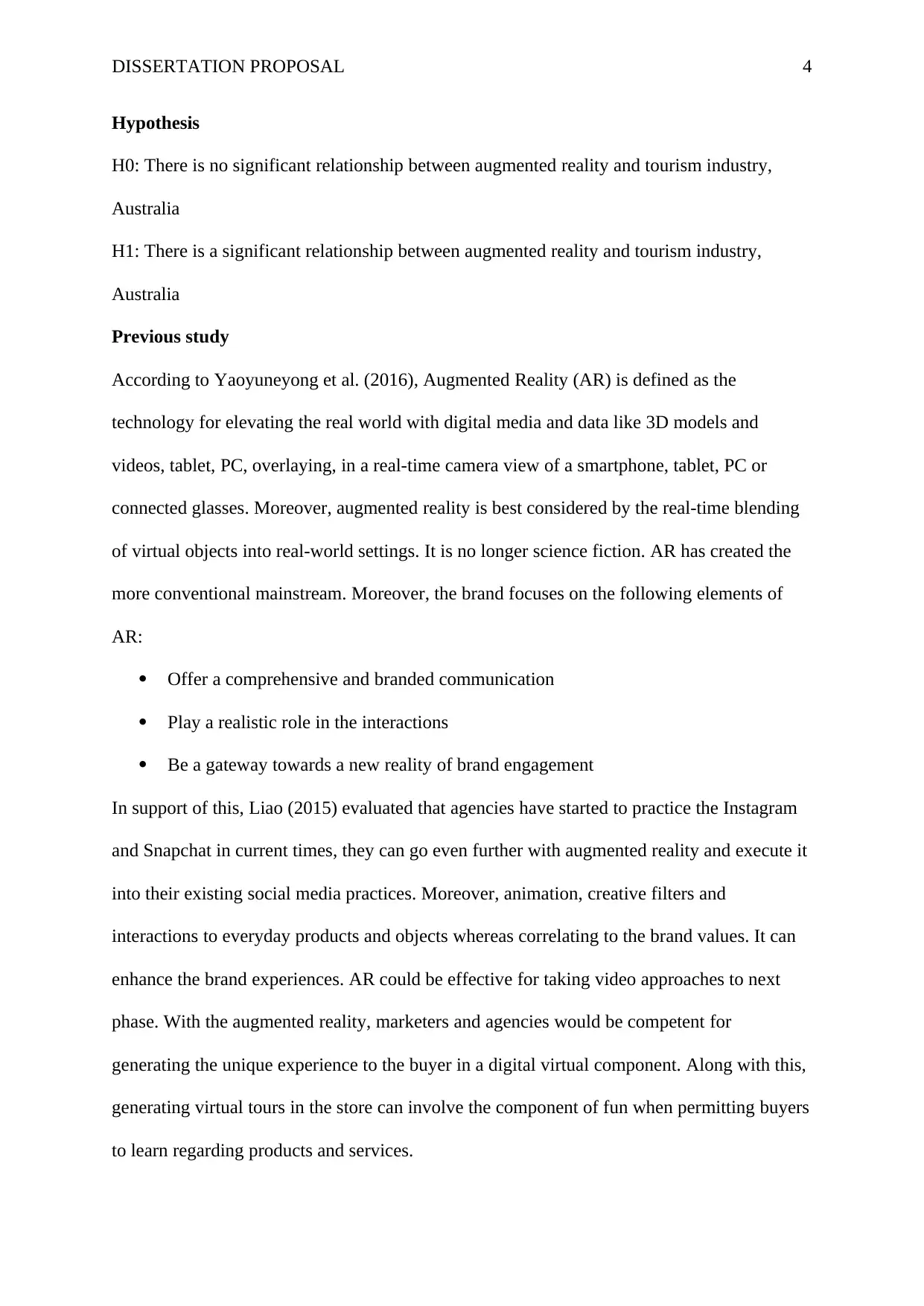
DISSERTATION PROPOSAL 4
Hypothesis
H0: There is no significant relationship between augmented reality and tourism industry,
Australia
H1: There is a significant relationship between augmented reality and tourism industry,
Australia
Previous study
According to Yaoyuneyong et al. (2016), Augmented Reality (AR) is defined as the
technology for elevating the real world with digital media and data like 3D models and
videos, tablet, PC, overlaying, in a real-time camera view of a smartphone, tablet, PC or
connected glasses. Moreover, augmented reality is best considered by the real-time blending
of virtual objects into real-world settings. It is no longer science fiction. AR has created the
more conventional mainstream. Moreover, the brand focuses on the following elements of
AR:
Offer a comprehensive and branded communication
Play a realistic role in the interactions
Be a gateway towards a new reality of brand engagement
In support of this, Liao (2015) evaluated that agencies have started to practice the Instagram
and Snapchat in current times, they can go even further with augmented reality and execute it
into their existing social media practices. Moreover, animation, creative filters and
interactions to everyday products and objects whereas correlating to the brand values. It can
enhance the brand experiences. AR could be effective for taking video approaches to next
phase. With the augmented reality, marketers and agencies would be competent for
generating the unique experience to the buyer in a digital virtual component. Along with this,
generating virtual tours in the store can involve the component of fun when permitting buyers
to learn regarding products and services.
Hypothesis
H0: There is no significant relationship between augmented reality and tourism industry,
Australia
H1: There is a significant relationship between augmented reality and tourism industry,
Australia
Previous study
According to Yaoyuneyong et al. (2016), Augmented Reality (AR) is defined as the
technology for elevating the real world with digital media and data like 3D models and
videos, tablet, PC, overlaying, in a real-time camera view of a smartphone, tablet, PC or
connected glasses. Moreover, augmented reality is best considered by the real-time blending
of virtual objects into real-world settings. It is no longer science fiction. AR has created the
more conventional mainstream. Moreover, the brand focuses on the following elements of
AR:
Offer a comprehensive and branded communication
Play a realistic role in the interactions
Be a gateway towards a new reality of brand engagement
In support of this, Liao (2015) evaluated that agencies have started to practice the Instagram
and Snapchat in current times, they can go even further with augmented reality and execute it
into their existing social media practices. Moreover, animation, creative filters and
interactions to everyday products and objects whereas correlating to the brand values. It can
enhance the brand experiences. AR could be effective for taking video approaches to next
phase. With the augmented reality, marketers and agencies would be competent for
generating the unique experience to the buyer in a digital virtual component. Along with this,
generating virtual tours in the store can involve the component of fun when permitting buyers
to learn regarding products and services.
Paraphrase This Document
Need a fresh take? Get an instant paraphrase of this document with our AI Paraphraser
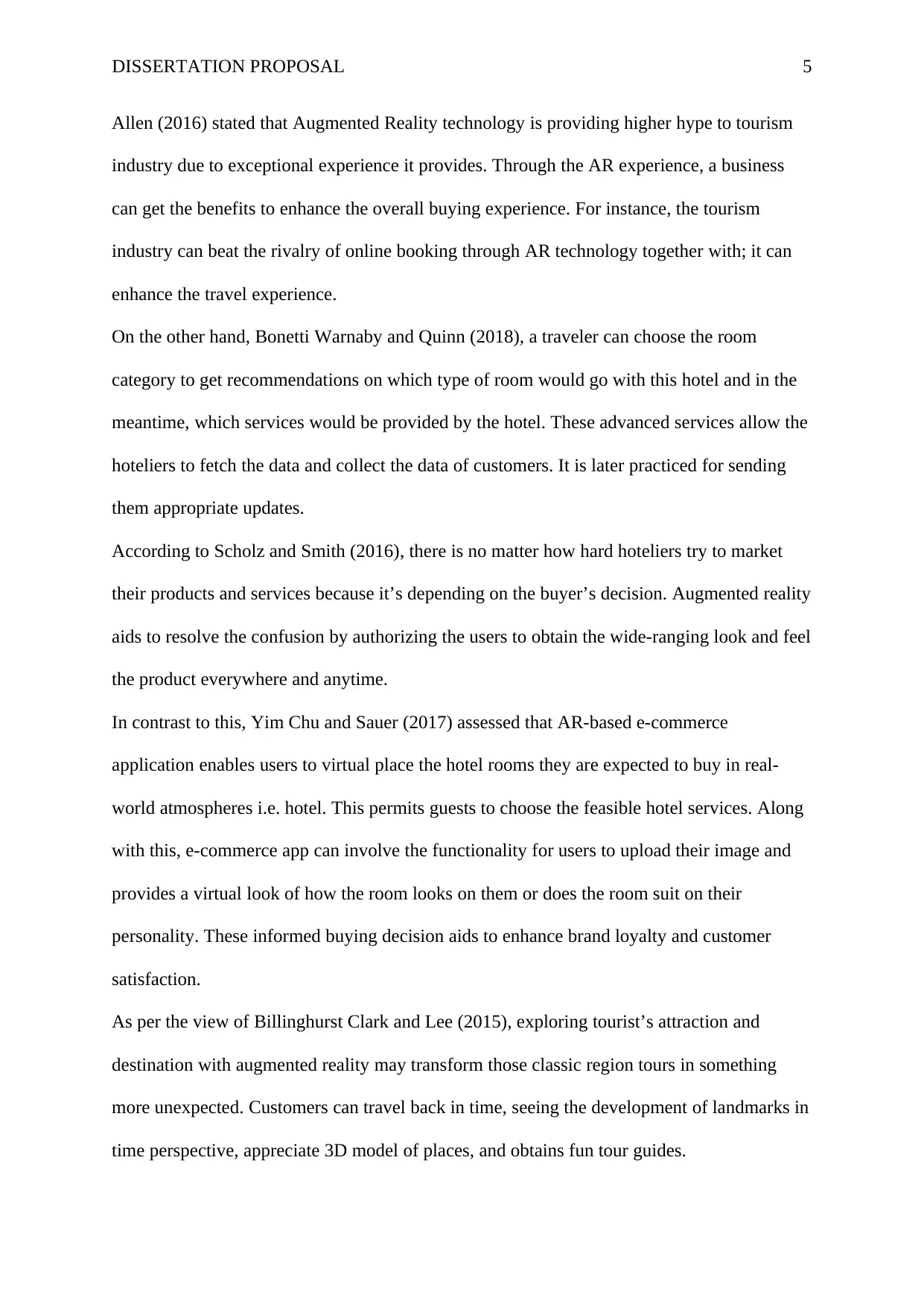
DISSERTATION PROPOSAL 5
Allen (2016) stated that Augmented Reality technology is providing higher hype to tourism
industry due to exceptional experience it provides. Through the AR experience, a business
can get the benefits to enhance the overall buying experience. For instance, the tourism
industry can beat the rivalry of online booking through AR technology together with; it can
enhance the travel experience.
On the other hand, Bonetti Warnaby and Quinn (2018), a traveler can choose the room
category to get recommendations on which type of room would go with this hotel and in the
meantime, which services would be provided by the hotel. These advanced services allow the
hoteliers to fetch the data and collect the data of customers. It is later practiced for sending
them appropriate updates.
According to Scholz and Smith (2016), there is no matter how hard hoteliers try to market
their products and services because it’s depending on the buyer’s decision. Augmented reality
aids to resolve the confusion by authorizing the users to obtain the wide-ranging look and feel
the product everywhere and anytime.
In contrast to this, Yim Chu and Sauer (2017) assessed that AR-based e-commerce
application enables users to virtual place the hotel rooms they are expected to buy in real-
world atmospheres i.e. hotel. This permits guests to choose the feasible hotel services. Along
with this, e-commerce app can involve the functionality for users to upload their image and
provides a virtual look of how the room looks on them or does the room suit on their
personality. These informed buying decision aids to enhance brand loyalty and customer
satisfaction.
As per the view of Billinghurst Clark and Lee (2015), exploring tourist’s attraction and
destination with augmented reality may transform those classic region tours in something
more unexpected. Customers can travel back in time, seeing the development of landmarks in
time perspective, appreciate 3D model of places, and obtains fun tour guides.
Allen (2016) stated that Augmented Reality technology is providing higher hype to tourism
industry due to exceptional experience it provides. Through the AR experience, a business
can get the benefits to enhance the overall buying experience. For instance, the tourism
industry can beat the rivalry of online booking through AR technology together with; it can
enhance the travel experience.
On the other hand, Bonetti Warnaby and Quinn (2018), a traveler can choose the room
category to get recommendations on which type of room would go with this hotel and in the
meantime, which services would be provided by the hotel. These advanced services allow the
hoteliers to fetch the data and collect the data of customers. It is later practiced for sending
them appropriate updates.
According to Scholz and Smith (2016), there is no matter how hard hoteliers try to market
their products and services because it’s depending on the buyer’s decision. Augmented reality
aids to resolve the confusion by authorizing the users to obtain the wide-ranging look and feel
the product everywhere and anytime.
In contrast to this, Yim Chu and Sauer (2017) assessed that AR-based e-commerce
application enables users to virtual place the hotel rooms they are expected to buy in real-
world atmospheres i.e. hotel. This permits guests to choose the feasible hotel services. Along
with this, e-commerce app can involve the functionality for users to upload their image and
provides a virtual look of how the room looks on them or does the room suit on their
personality. These informed buying decision aids to enhance brand loyalty and customer
satisfaction.
As per the view of Billinghurst Clark and Lee (2015), exploring tourist’s attraction and
destination with augmented reality may transform those classic region tours in something
more unexpected. Customers can travel back in time, seeing the development of landmarks in
time perspective, appreciate 3D model of places, and obtains fun tour guides.
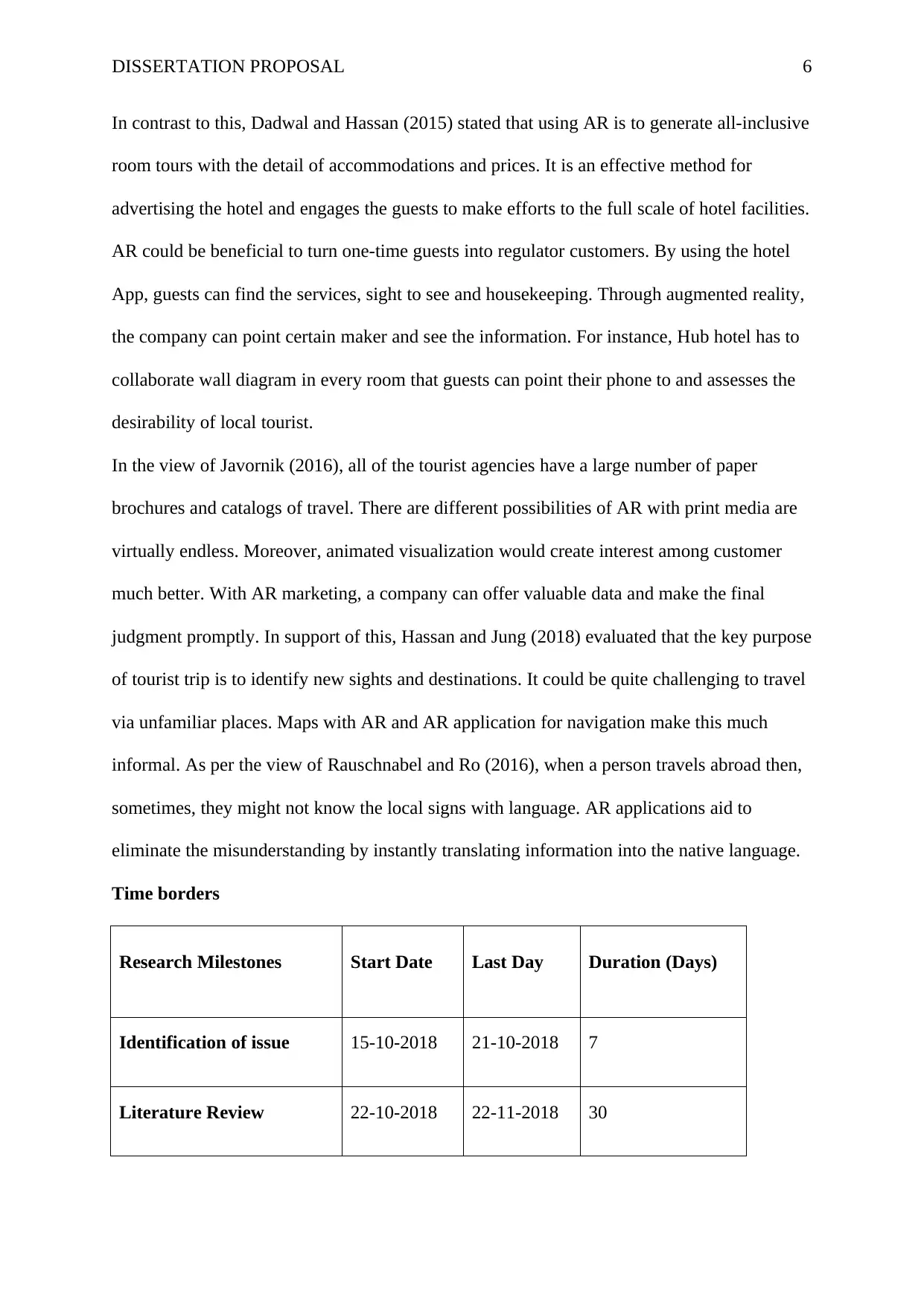
DISSERTATION PROPOSAL 6
In contrast to this, Dadwal and Hassan (2015) stated that using AR is to generate all-inclusive
room tours with the detail of accommodations and prices. It is an effective method for
advertising the hotel and engages the guests to make efforts to the full scale of hotel facilities.
AR could be beneficial to turn one-time guests into regulator customers. By using the hotel
App, guests can find the services, sight to see and housekeeping. Through augmented reality,
the company can point certain maker and see the information. For instance, Hub hotel has to
collaborate wall diagram in every room that guests can point their phone to and assesses the
desirability of local tourist.
In the view of Javornik (2016), all of the tourist agencies have a large number of paper
brochures and catalogs of travel. There are different possibilities of AR with print media are
virtually endless. Moreover, animated visualization would create interest among customer
much better. With AR marketing, a company can offer valuable data and make the final
judgment promptly. In support of this, Hassan and Jung (2018) evaluated that the key purpose
of tourist trip is to identify new sights and destinations. It could be quite challenging to travel
via unfamiliar places. Maps with AR and AR application for navigation make this much
informal. As per the view of Rauschnabel and Ro (2016), when a person travels abroad then,
sometimes, they might not know the local signs with language. AR applications aid to
eliminate the misunderstanding by instantly translating information into the native language.
Time borders
Research Milestones Start Date Last Day Duration (Days)
Identification of issue 15-10-2018 21-10-2018 7
Literature Review 22-10-2018 22-11-2018 30
In contrast to this, Dadwal and Hassan (2015) stated that using AR is to generate all-inclusive
room tours with the detail of accommodations and prices. It is an effective method for
advertising the hotel and engages the guests to make efforts to the full scale of hotel facilities.
AR could be beneficial to turn one-time guests into regulator customers. By using the hotel
App, guests can find the services, sight to see and housekeeping. Through augmented reality,
the company can point certain maker and see the information. For instance, Hub hotel has to
collaborate wall diagram in every room that guests can point their phone to and assesses the
desirability of local tourist.
In the view of Javornik (2016), all of the tourist agencies have a large number of paper
brochures and catalogs of travel. There are different possibilities of AR with print media are
virtually endless. Moreover, animated visualization would create interest among customer
much better. With AR marketing, a company can offer valuable data and make the final
judgment promptly. In support of this, Hassan and Jung (2018) evaluated that the key purpose
of tourist trip is to identify new sights and destinations. It could be quite challenging to travel
via unfamiliar places. Maps with AR and AR application for navigation make this much
informal. As per the view of Rauschnabel and Ro (2016), when a person travels abroad then,
sometimes, they might not know the local signs with language. AR applications aid to
eliminate the misunderstanding by instantly translating information into the native language.
Time borders
Research Milestones Start Date Last Day Duration (Days)
Identification of issue 15-10-2018 21-10-2018 7
Literature Review 22-10-2018 22-11-2018 30
⊘ This is a preview!⊘
Do you want full access?
Subscribe today to unlock all pages.

Trusted by 1+ million students worldwide
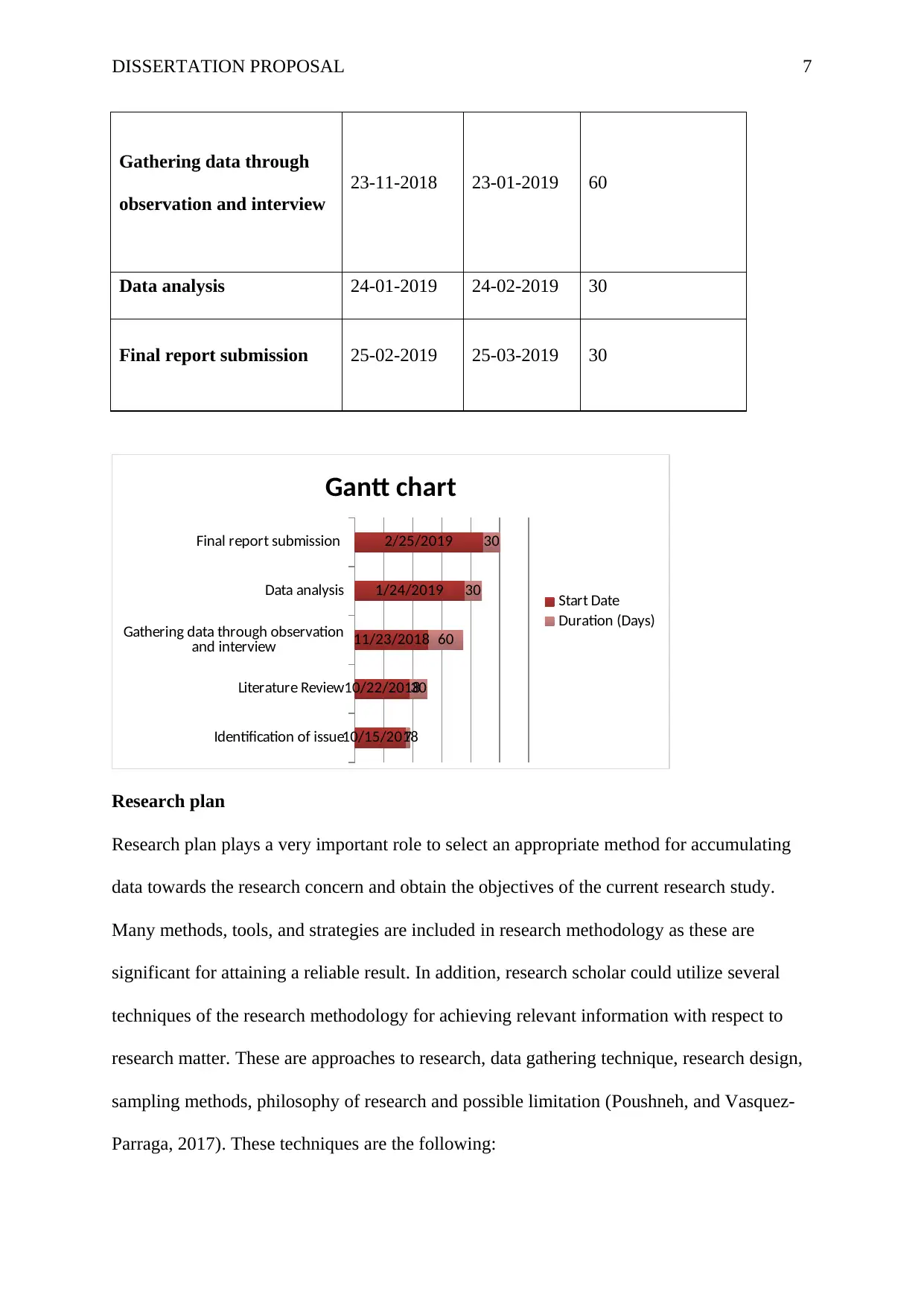
DISSERTATION PROPOSAL 7
Gathering data through
observation and interview
23-11-2018 23-01-2019 60
Data analysis 24-01-2019 24-02-2019 30
Final report submission 25-02-2019 25-03-2019 30
Identification of issue
Literature Review
Gathering data through observation
and interview
Data analysis
Final report submission
10/15/2018
10/22/2018
11/23/2018
1/24/2019
2/25/2019
7
30
60
30
30
Gantt chart
Start Date
Duration (Days)
Research plan
Research plan plays a very important role to select an appropriate method for accumulating
data towards the research concern and obtain the objectives of the current research study.
Many methods, tools, and strategies are included in research methodology as these are
significant for attaining a reliable result. In addition, research scholar could utilize several
techniques of the research methodology for achieving relevant information with respect to
research matter. These are approaches to research, data gathering technique, research design,
sampling methods, philosophy of research and possible limitation (Poushneh, and Vasquez-
Parraga, 2017). These techniques are the following:
Gathering data through
observation and interview
23-11-2018 23-01-2019 60
Data analysis 24-01-2019 24-02-2019 30
Final report submission 25-02-2019 25-03-2019 30
Identification of issue
Literature Review
Gathering data through observation
and interview
Data analysis
Final report submission
10/15/2018
10/22/2018
11/23/2018
1/24/2019
2/25/2019
7
30
60
30
30
Gantt chart
Start Date
Duration (Days)
Research plan
Research plan plays a very important role to select an appropriate method for accumulating
data towards the research concern and obtain the objectives of the current research study.
Many methods, tools, and strategies are included in research methodology as these are
significant for attaining a reliable result. In addition, research scholar could utilize several
techniques of the research methodology for achieving relevant information with respect to
research matter. These are approaches to research, data gathering technique, research design,
sampling methods, philosophy of research and possible limitation (Poushneh, and Vasquez-
Parraga, 2017). These techniques are the following:
Paraphrase This Document
Need a fresh take? Get an instant paraphrase of this document with our AI Paraphraser
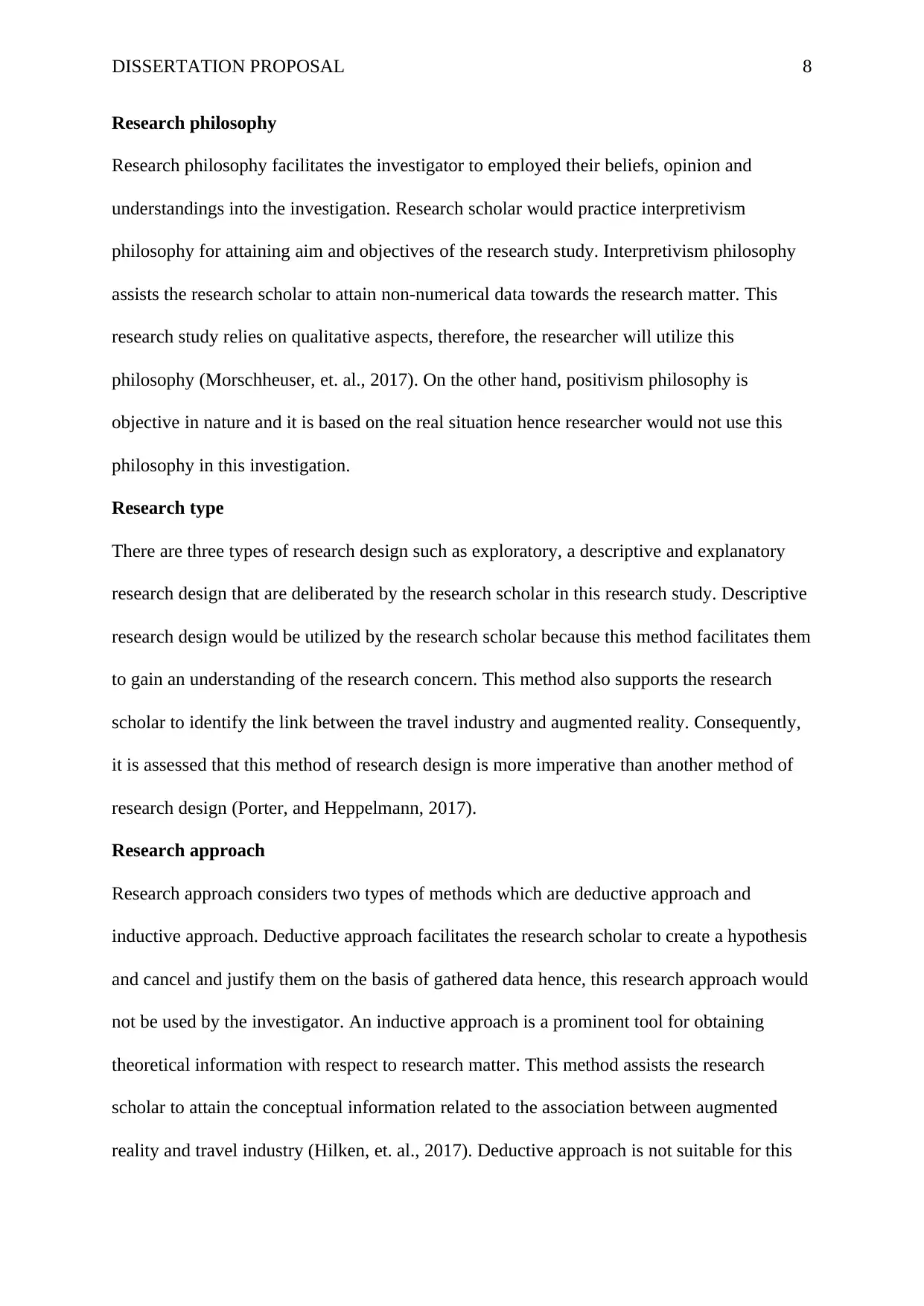
DISSERTATION PROPOSAL 8
Research philosophy
Research philosophy facilitates the investigator to employed their beliefs, opinion and
understandings into the investigation. Research scholar would practice interpretivism
philosophy for attaining aim and objectives of the research study. Interpretivism philosophy
assists the research scholar to attain non-numerical data towards the research matter. This
research study relies on qualitative aspects, therefore, the researcher will utilize this
philosophy (Morschheuser, et. al., 2017). On the other hand, positivism philosophy is
objective in nature and it is based on the real situation hence researcher would not use this
philosophy in this investigation.
Research type
There are three types of research design such as exploratory, a descriptive and explanatory
research design that are deliberated by the research scholar in this research study. Descriptive
research design would be utilized by the research scholar because this method facilitates them
to gain an understanding of the research concern. This method also supports the research
scholar to identify the link between the travel industry and augmented reality. Consequently,
it is assessed that this method of research design is more imperative than another method of
research design (Porter, and Heppelmann, 2017).
Research approach
Research approach considers two types of methods which are deductive approach and
inductive approach. Deductive approach facilitates the research scholar to create a hypothesis
and cancel and justify them on the basis of gathered data hence, this research approach would
not be used by the investigator. An inductive approach is a prominent tool for obtaining
theoretical information with respect to research matter. This method assists the research
scholar to attain the conceptual information related to the association between augmented
reality and travel industry (Hilken, et. al., 2017). Deductive approach is not suitable for this
Research philosophy
Research philosophy facilitates the investigator to employed their beliefs, opinion and
understandings into the investigation. Research scholar would practice interpretivism
philosophy for attaining aim and objectives of the research study. Interpretivism philosophy
assists the research scholar to attain non-numerical data towards the research matter. This
research study relies on qualitative aspects, therefore, the researcher will utilize this
philosophy (Morschheuser, et. al., 2017). On the other hand, positivism philosophy is
objective in nature and it is based on the real situation hence researcher would not use this
philosophy in this investigation.
Research type
There are three types of research design such as exploratory, a descriptive and explanatory
research design that are deliberated by the research scholar in this research study. Descriptive
research design would be utilized by the research scholar because this method facilitates them
to gain an understanding of the research concern. This method also supports the research
scholar to identify the link between the travel industry and augmented reality. Consequently,
it is assessed that this method of research design is more imperative than another method of
research design (Porter, and Heppelmann, 2017).
Research approach
Research approach considers two types of methods which are deductive approach and
inductive approach. Deductive approach facilitates the research scholar to create a hypothesis
and cancel and justify them on the basis of gathered data hence, this research approach would
not be used by the investigator. An inductive approach is a prominent tool for obtaining
theoretical information with respect to research matter. This method assists the research
scholar to attain the conceptual information related to the association between augmented
reality and travel industry (Hilken, et. al., 2017). Deductive approach is not suitable for this
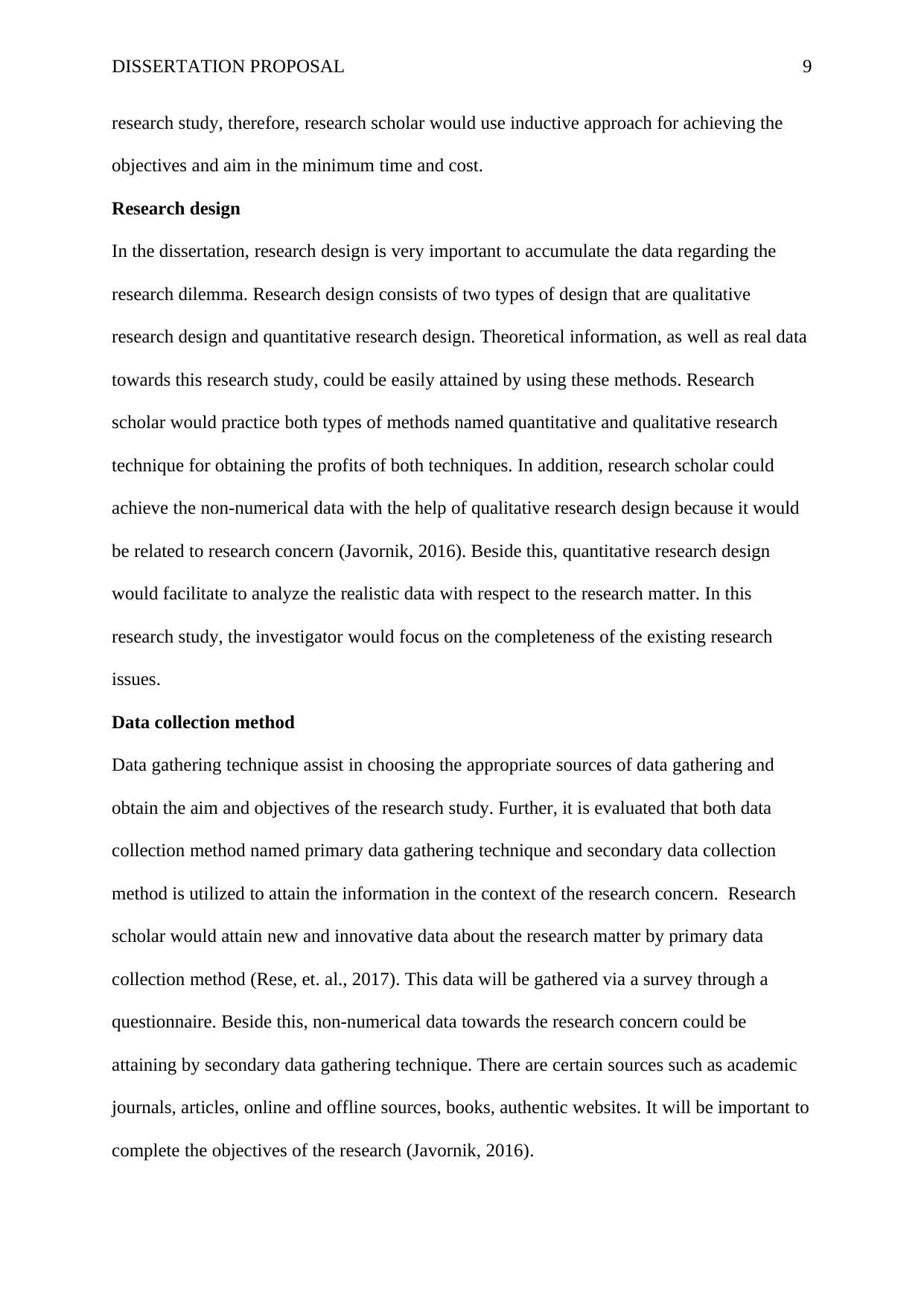
DISSERTATION PROPOSAL 9
research study, therefore, research scholar would use inductive approach for achieving the
objectives and aim in the minimum time and cost.
Research design
In the dissertation, research design is very important to accumulate the data regarding the
research dilemma. Research design consists of two types of design that are qualitative
research design and quantitative research design. Theoretical information, as well as real data
towards this research study, could be easily attained by using these methods. Research
scholar would practice both types of methods named quantitative and qualitative research
technique for obtaining the profits of both techniques. In addition, research scholar could
achieve the non-numerical data with the help of qualitative research design because it would
be related to research concern (Javornik, 2016). Beside this, quantitative research design
would facilitate to analyze the realistic data with respect to the research matter. In this
research study, the investigator would focus on the completeness of the existing research
issues.
Data collection method
Data gathering technique assist in choosing the appropriate sources of data gathering and
obtain the aim and objectives of the research study. Further, it is evaluated that both data
collection method named primary data gathering technique and secondary data collection
method is utilized to attain the information in the context of the research concern. Research
scholar would attain new and innovative data about the research matter by primary data
collection method (Rese, et. al., 2017). This data will be gathered via a survey through a
questionnaire. Beside this, non-numerical data towards the research concern could be
attaining by secondary data gathering technique. There are certain sources such as academic
journals, articles, online and offline sources, books, authentic websites. It will be important to
complete the objectives of the research (Javornik, 2016).
research study, therefore, research scholar would use inductive approach for achieving the
objectives and aim in the minimum time and cost.
Research design
In the dissertation, research design is very important to accumulate the data regarding the
research dilemma. Research design consists of two types of design that are qualitative
research design and quantitative research design. Theoretical information, as well as real data
towards this research study, could be easily attained by using these methods. Research
scholar would practice both types of methods named quantitative and qualitative research
technique for obtaining the profits of both techniques. In addition, research scholar could
achieve the non-numerical data with the help of qualitative research design because it would
be related to research concern (Javornik, 2016). Beside this, quantitative research design
would facilitate to analyze the realistic data with respect to the research matter. In this
research study, the investigator would focus on the completeness of the existing research
issues.
Data collection method
Data gathering technique assist in choosing the appropriate sources of data gathering and
obtain the aim and objectives of the research study. Further, it is evaluated that both data
collection method named primary data gathering technique and secondary data collection
method is utilized to attain the information in the context of the research concern. Research
scholar would attain new and innovative data about the research matter by primary data
collection method (Rese, et. al., 2017). This data will be gathered via a survey through a
questionnaire. Beside this, non-numerical data towards the research concern could be
attaining by secondary data gathering technique. There are certain sources such as academic
journals, articles, online and offline sources, books, authentic websites. It will be important to
complete the objectives of the research (Javornik, 2016).
⊘ This is a preview!⊘
Do you want full access?
Subscribe today to unlock all pages.

Trusted by 1+ million students worldwide
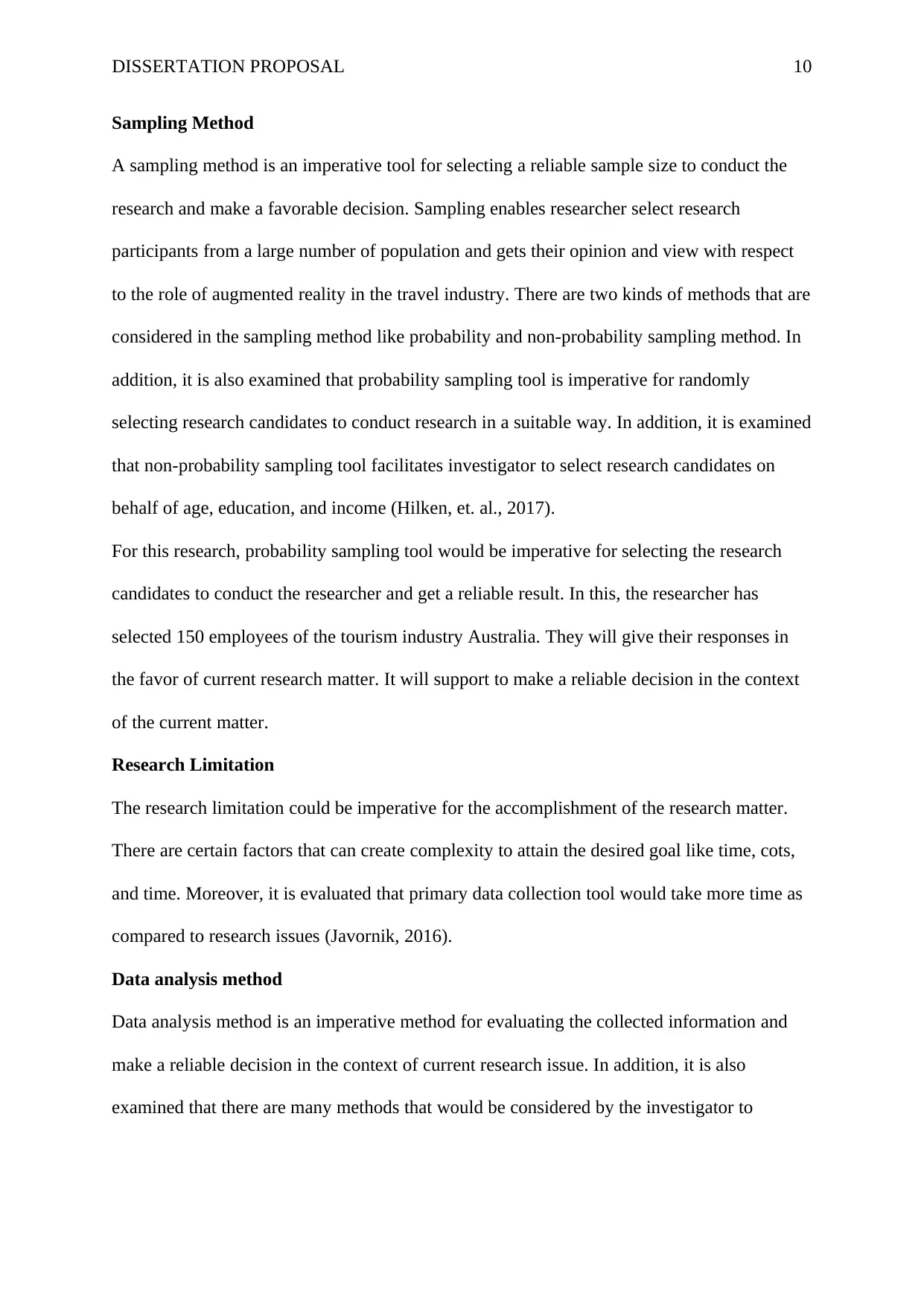
DISSERTATION PROPOSAL 10
Sampling Method
A sampling method is an imperative tool for selecting a reliable sample size to conduct the
research and make a favorable decision. Sampling enables researcher select research
participants from a large number of population and gets their opinion and view with respect
to the role of augmented reality in the travel industry. There are two kinds of methods that are
considered in the sampling method like probability and non-probability sampling method. In
addition, it is also examined that probability sampling tool is imperative for randomly
selecting research candidates to conduct research in a suitable way. In addition, it is examined
that non-probability sampling tool facilitates investigator to select research candidates on
behalf of age, education, and income (Hilken, et. al., 2017).
For this research, probability sampling tool would be imperative for selecting the research
candidates to conduct the researcher and get a reliable result. In this, the researcher has
selected 150 employees of the tourism industry Australia. They will give their responses in
the favor of current research matter. It will support to make a reliable decision in the context
of the current matter.
Research Limitation
The research limitation could be imperative for the accomplishment of the research matter.
There are certain factors that can create complexity to attain the desired goal like time, cots,
and time. Moreover, it is evaluated that primary data collection tool would take more time as
compared to research issues (Javornik, 2016).
Data analysis method
Data analysis method is an imperative method for evaluating the collected information and
make a reliable decision in the context of current research issue. In addition, it is also
examined that there are many methods that would be considered by the investigator to
Sampling Method
A sampling method is an imperative tool for selecting a reliable sample size to conduct the
research and make a favorable decision. Sampling enables researcher select research
participants from a large number of population and gets their opinion and view with respect
to the role of augmented reality in the travel industry. There are two kinds of methods that are
considered in the sampling method like probability and non-probability sampling method. In
addition, it is also examined that probability sampling tool is imperative for randomly
selecting research candidates to conduct research in a suitable way. In addition, it is examined
that non-probability sampling tool facilitates investigator to select research candidates on
behalf of age, education, and income (Hilken, et. al., 2017).
For this research, probability sampling tool would be imperative for selecting the research
candidates to conduct the researcher and get a reliable result. In this, the researcher has
selected 150 employees of the tourism industry Australia. They will give their responses in
the favor of current research matter. It will support to make a reliable decision in the context
of the current matter.
Research Limitation
The research limitation could be imperative for the accomplishment of the research matter.
There are certain factors that can create complexity to attain the desired goal like time, cots,
and time. Moreover, it is evaluated that primary data collection tool would take more time as
compared to research issues (Javornik, 2016).
Data analysis method
Data analysis method is an imperative method for evaluating the collected information and
make a reliable decision in the context of current research issue. In addition, it is also
examined that there are many methods that would be considered by the investigator to
Paraphrase This Document
Need a fresh take? Get an instant paraphrase of this document with our AI Paraphraser
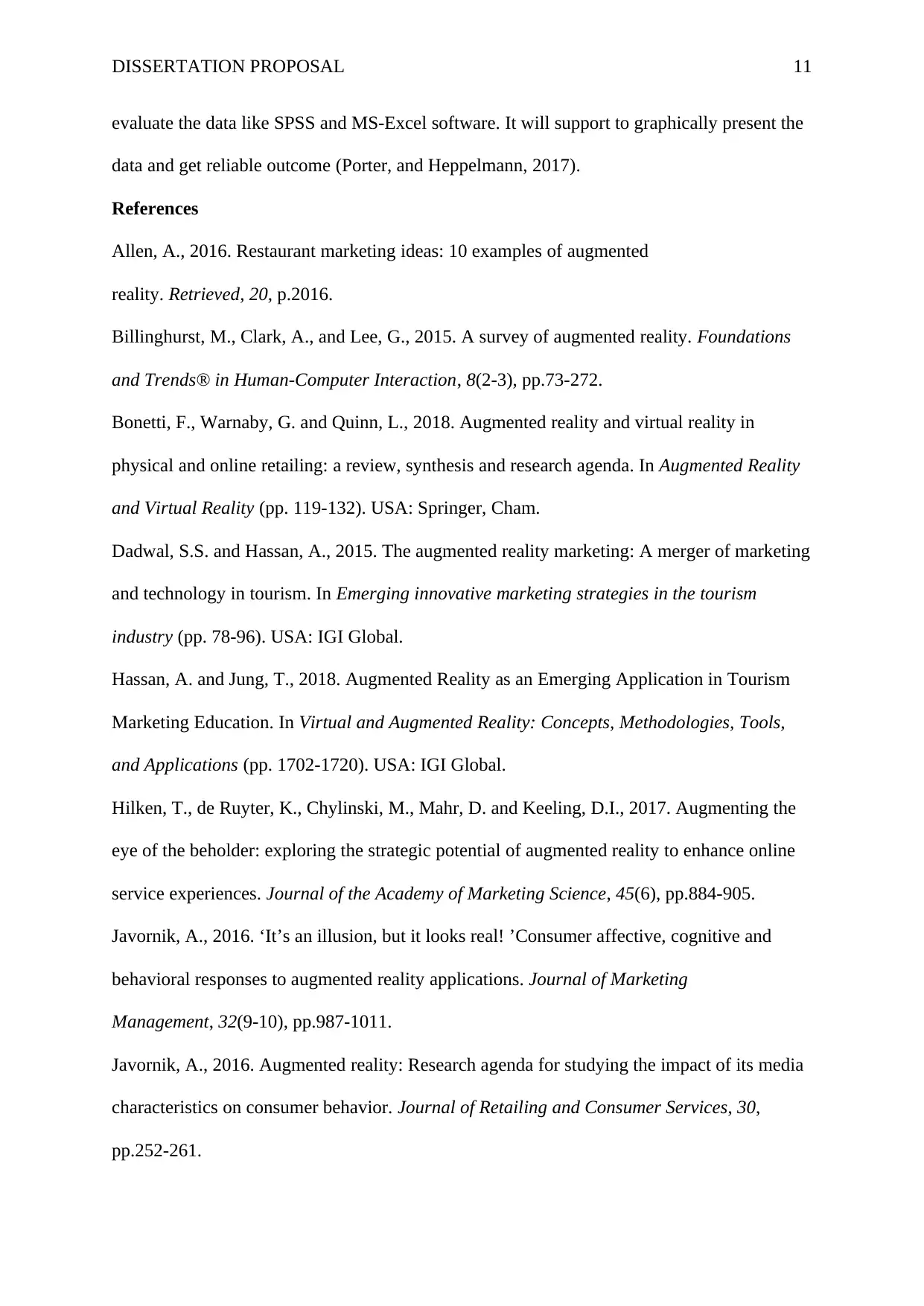
DISSERTATION PROPOSAL 11
evaluate the data like SPSS and MS-Excel software. It will support to graphically present the
data and get reliable outcome (Porter, and Heppelmann, 2017).
References
Allen, A., 2016. Restaurant marketing ideas: 10 examples of augmented
reality. Retrieved, 20, p.2016.
Billinghurst, M., Clark, A., and Lee, G., 2015. A survey of augmented reality. Foundations
and Trends® in Human-Computer Interaction, 8(2-3), pp.73-272.
Bonetti, F., Warnaby, G. and Quinn, L., 2018. Augmented reality and virtual reality in
physical and online retailing: a review, synthesis and research agenda. In Augmented Reality
and Virtual Reality (pp. 119-132). USA: Springer, Cham.
Dadwal, S.S. and Hassan, A., 2015. The augmented reality marketing: A merger of marketing
and technology in tourism. In Emerging innovative marketing strategies in the tourism
industry (pp. 78-96). USA: IGI Global.
Hassan, A. and Jung, T., 2018. Augmented Reality as an Emerging Application in Tourism
Marketing Education. In Virtual and Augmented Reality: Concepts, Methodologies, Tools,
and Applications (pp. 1702-1720). USA: IGI Global.
Hilken, T., de Ruyter, K., Chylinski, M., Mahr, D. and Keeling, D.I., 2017. Augmenting the
eye of the beholder: exploring the strategic potential of augmented reality to enhance online
service experiences. Journal of the Academy of Marketing Science, 45(6), pp.884-905.
Javornik, A., 2016. ‘It’s an illusion, but it looks real! ’Consumer affective, cognitive and
behavioral responses to augmented reality applications. Journal of Marketing
Management, 32(9-10), pp.987-1011.
Javornik, A., 2016. Augmented reality: Research agenda for studying the impact of its media
characteristics on consumer behavior. Journal of Retailing and Consumer Services, 30,
pp.252-261.
evaluate the data like SPSS and MS-Excel software. It will support to graphically present the
data and get reliable outcome (Porter, and Heppelmann, 2017).
References
Allen, A., 2016. Restaurant marketing ideas: 10 examples of augmented
reality. Retrieved, 20, p.2016.
Billinghurst, M., Clark, A., and Lee, G., 2015. A survey of augmented reality. Foundations
and Trends® in Human-Computer Interaction, 8(2-3), pp.73-272.
Bonetti, F., Warnaby, G. and Quinn, L., 2018. Augmented reality and virtual reality in
physical and online retailing: a review, synthesis and research agenda. In Augmented Reality
and Virtual Reality (pp. 119-132). USA: Springer, Cham.
Dadwal, S.S. and Hassan, A., 2015. The augmented reality marketing: A merger of marketing
and technology in tourism. In Emerging innovative marketing strategies in the tourism
industry (pp. 78-96). USA: IGI Global.
Hassan, A. and Jung, T., 2018. Augmented Reality as an Emerging Application in Tourism
Marketing Education. In Virtual and Augmented Reality: Concepts, Methodologies, Tools,
and Applications (pp. 1702-1720). USA: IGI Global.
Hilken, T., de Ruyter, K., Chylinski, M., Mahr, D. and Keeling, D.I., 2017. Augmenting the
eye of the beholder: exploring the strategic potential of augmented reality to enhance online
service experiences. Journal of the Academy of Marketing Science, 45(6), pp.884-905.
Javornik, A., 2016. ‘It’s an illusion, but it looks real! ’Consumer affective, cognitive and
behavioral responses to augmented reality applications. Journal of Marketing
Management, 32(9-10), pp.987-1011.
Javornik, A., 2016. Augmented reality: Research agenda for studying the impact of its media
characteristics on consumer behavior. Journal of Retailing and Consumer Services, 30,
pp.252-261.
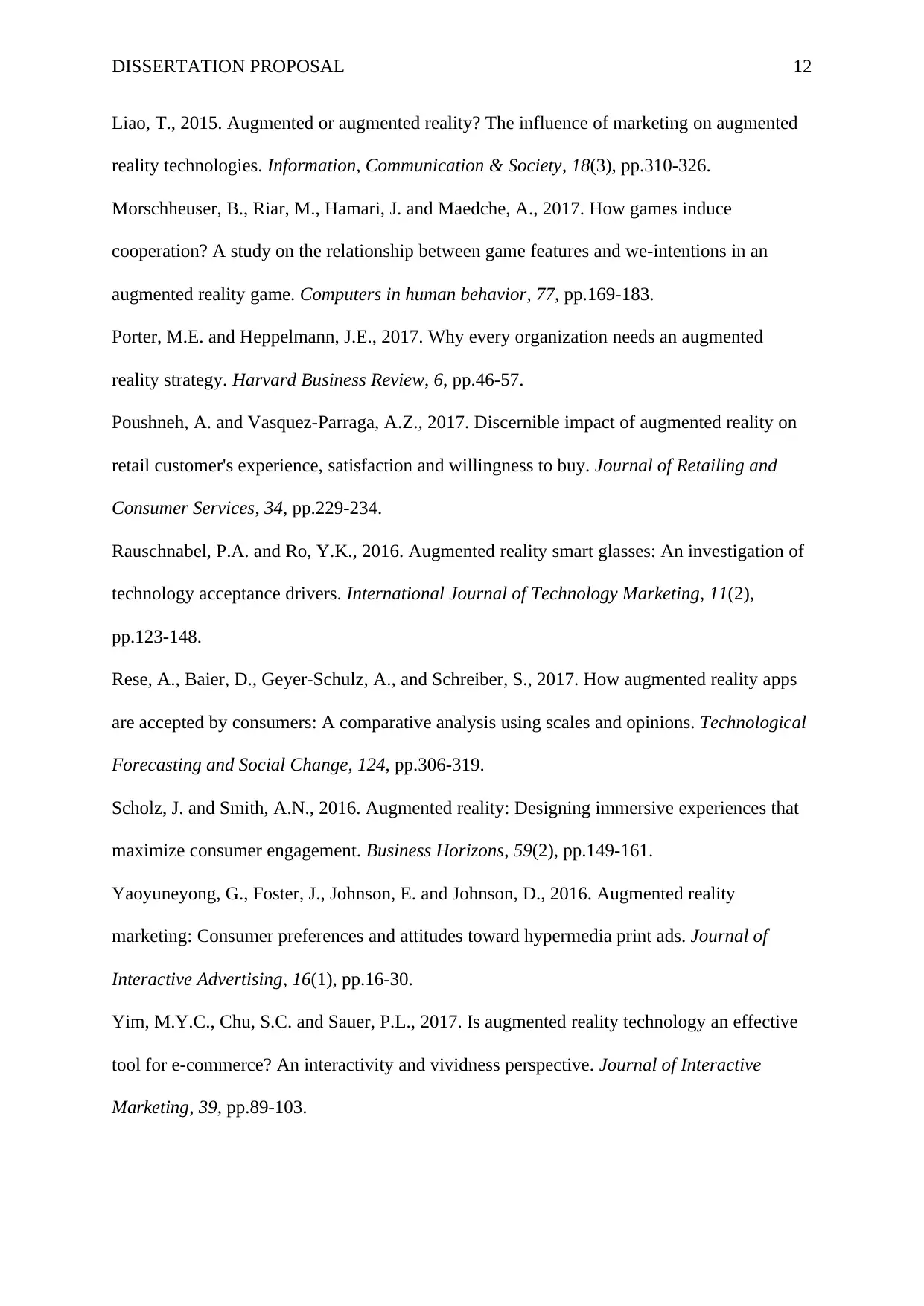
DISSERTATION PROPOSAL 12
Liao, T., 2015. Augmented or augmented reality? The influence of marketing on augmented
reality technologies. Information, Communication & Society, 18(3), pp.310-326.
Morschheuser, B., Riar, M., Hamari, J. and Maedche, A., 2017. How games induce
cooperation? A study on the relationship between game features and we-intentions in an
augmented reality game. Computers in human behavior, 77, pp.169-183.
Porter, M.E. and Heppelmann, J.E., 2017. Why every organization needs an augmented
reality strategy. Harvard Business Review, 6, pp.46-57.
Poushneh, A. and Vasquez-Parraga, A.Z., 2017. Discernible impact of augmented reality on
retail customer's experience, satisfaction and willingness to buy. Journal of Retailing and
Consumer Services, 34, pp.229-234.
Rauschnabel, P.A. and Ro, Y.K., 2016. Augmented reality smart glasses: An investigation of
technology acceptance drivers. International Journal of Technology Marketing, 11(2),
pp.123-148.
Rese, A., Baier, D., Geyer-Schulz, A., and Schreiber, S., 2017. How augmented reality apps
are accepted by consumers: A comparative analysis using scales and opinions. Technological
Forecasting and Social Change, 124, pp.306-319.
Scholz, J. and Smith, A.N., 2016. Augmented reality: Designing immersive experiences that
maximize consumer engagement. Business Horizons, 59(2), pp.149-161.
Yaoyuneyong, G., Foster, J., Johnson, E. and Johnson, D., 2016. Augmented reality
marketing: Consumer preferences and attitudes toward hypermedia print ads. Journal of
Interactive Advertising, 16(1), pp.16-30.
Yim, M.Y.C., Chu, S.C. and Sauer, P.L., 2017. Is augmented reality technology an effective
tool for e-commerce? An interactivity and vividness perspective. Journal of Interactive
Marketing, 39, pp.89-103.
Liao, T., 2015. Augmented or augmented reality? The influence of marketing on augmented
reality technologies. Information, Communication & Society, 18(3), pp.310-326.
Morschheuser, B., Riar, M., Hamari, J. and Maedche, A., 2017. How games induce
cooperation? A study on the relationship between game features and we-intentions in an
augmented reality game. Computers in human behavior, 77, pp.169-183.
Porter, M.E. and Heppelmann, J.E., 2017. Why every organization needs an augmented
reality strategy. Harvard Business Review, 6, pp.46-57.
Poushneh, A. and Vasquez-Parraga, A.Z., 2017. Discernible impact of augmented reality on
retail customer's experience, satisfaction and willingness to buy. Journal of Retailing and
Consumer Services, 34, pp.229-234.
Rauschnabel, P.A. and Ro, Y.K., 2016. Augmented reality smart glasses: An investigation of
technology acceptance drivers. International Journal of Technology Marketing, 11(2),
pp.123-148.
Rese, A., Baier, D., Geyer-Schulz, A., and Schreiber, S., 2017. How augmented reality apps
are accepted by consumers: A comparative analysis using scales and opinions. Technological
Forecasting and Social Change, 124, pp.306-319.
Scholz, J. and Smith, A.N., 2016. Augmented reality: Designing immersive experiences that
maximize consumer engagement. Business Horizons, 59(2), pp.149-161.
Yaoyuneyong, G., Foster, J., Johnson, E. and Johnson, D., 2016. Augmented reality
marketing: Consumer preferences and attitudes toward hypermedia print ads. Journal of
Interactive Advertising, 16(1), pp.16-30.
Yim, M.Y.C., Chu, S.C. and Sauer, P.L., 2017. Is augmented reality technology an effective
tool for e-commerce? An interactivity and vividness perspective. Journal of Interactive
Marketing, 39, pp.89-103.
⊘ This is a preview!⊘
Do you want full access?
Subscribe today to unlock all pages.

Trusted by 1+ million students worldwide
1 out of 13
Related Documents
Your All-in-One AI-Powered Toolkit for Academic Success.
+13062052269
info@desklib.com
Available 24*7 on WhatsApp / Email
![[object Object]](/_next/static/media/star-bottom.7253800d.svg)
Unlock your academic potential
Copyright © 2020–2025 A2Z Services. All Rights Reserved. Developed and managed by ZUCOL.





